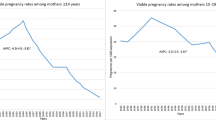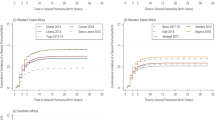Abstract
Public health prevalence data has consistently illustrated disparities in fetal mortality prevalence on a yearly basis, yet few studies have examined the prevalence and correlates of pregnancy loss history during the reproductive life span. Using nationally representative data from the Early Childhood Longitudinal Study, Birth Cohort, approximately 25% of childbearing women in the United States were found to have experienced one or more fetal deaths prior to the current live birth. An examination of the demographic correlates of singular and multiple loss history in age-controlled models reveals that a history of multiple loss was significantly related to African-American race, lower socioeconomic status, income below poverty, and lower maternal education. Singular loss history risk was relatively consistent across social and demographic groups with some increased risk noted only for African-American women. Predictive correlates of fetal mortality varied by racial-ethnic subpopulation in multivariate analysis. Findings from this study are discussed for their contribution to existing public health knowledge and the potential for future research focused on the experience of multiple loss and demographic groups at elevated risk.
Similar content being viewed by others
Notes
http://www.stata.com/support/faqs/stat/stratum.html, accessed 5/2/05.
References
Arias E, Anderson RN, Kung HC, Murphy LL, Kochanek KD. Deaths: final data for 2001. Natl Vital Stat Rep 2003;52:125.
Chen C. Early reproductive loss. Aust N Z J Obstet Gynecol 1986;26:215.
Creinin M, Schwartz J, Guido R, Pymar H. Early pregnancy failure–early management concepts. Obstet Gynecol Surv 2001;56:105–113.
Phares T, Morrow B, Lansky A, et al. Surveillance for disparities in maternal health related behaviors–selected states, Pregnancy Risk Assessment Monitoring System (PRAMS), 2000–2001. Morb Mortal Wkly Rep Surveill Summ 2004;53:1–13.
Williams LM, Morrow B, Lansky A, et al. Surveillance for selected maternal behaviors and experiences before, during, and after pregnancy. Morb Mortal Wkly Rep Surveill Summ 2003;52(SS11):1–14.
Wise PH. The anatomy of a disparity in infant mortality. Annu Rev Public Health 2003;24:341–362.
Lu M, Halfon N. Racial and ethnic disparities in birth outcomes: a life-course perspective. Matern Child Health J 2003;7:13–30.
Hoyert DL. Fetal mortality by maternal education and prenatal care, 1990. Natl Cent Health Stat Vital Health Stat 1996;20:30.
Alexander GR, Kotelchuck M. Assessing the role and effectiveness of prenatal care: history, challenges, and directions for future research. Public Health Rep 2001;116:306–316.
Wegman ME. Infant Mortality in the 20th Century: Dramatic but uneven progress. Am Soc Nutr Sci, J Nutr 2001;131:401–408.
Sable M, Herman A. The relationship between prenatal health behavior advice and low birth weight. Public Health Rep 1997;112:332–339.
Misra DP, Guyer B, Allston A. Integrated perinatal health framework: a multiple determinants model with a lifespan approach. Am J Prev Med 2003;25:65–75.
National Center for Education Statistics. Early Child Longitudinal Study—Birth Cohort: Users manual for the ECLS-B 9 month public use data file and electronic code book. U.S. Department of Education; 2005.
Fretts R, Schmittdiel J, McLean F, Usher R, Goldman B. Increased maternal age and the risk of fetal death. N Engl J Med 1995;333:1002–1004.
Milner M, Barry-Kinsella C, Unwin A, Harrison R. The impact of maternal age on pregnancy and its outcome. Int J Gynecol Obstet 1992;38:281–286.
Salihu H, Shumpert M, Slay M, Kirby R, Alexander G. Childbearing beyond age 50 and fetal outcomes in the United States. Obstet Gynecol 2003;102:1006–1014.
Buekens P, Notzon F, Kotelchuck M, Wilcox A. Why Do Mexican Americans Give Birth to Few Low Birth-Weight Infants? Am J Epidemiol 2000;152:347–351.
Palloni A, Morenoff J. Interpreting the paradoxical in the Hispanic Paradox: Demographic and epidemiological approaches. Ann N Y Acad Sci 2001;954:140–518.
Author information
Authors and Affiliations
Corresponding author
Rights and permissions
About this article
Cite this article
Price, S.K. Prevalence and Correlates of Pregnancy Loss History in a National Sample of Children and Families. Matern Child Health J 10, 489–500 (2006). https://doi.org/10.1007/s10995-006-0123-x
Published:
Issue Date:
DOI: https://doi.org/10.1007/s10995-006-0123-x




